2020 has seen huge changes and for business perhaps the biggest impact has been in the workplace. Before COVID-19, only 18% of employees regularly worked remotely but lockdowns meant that companies who had not considered allowing employees to work from home suddenly needed to adapt. The global pandemic introduced flexibility in the workplace more quickly than may have otherwise been the case.
Of course, not all businesses have the option to move their location or allow their employees to work remotely. But for organisations with a traditional office, a key question is what the long-term impact of these changes may be. Will employees continue to want to work remotely or is their mental health suffering due to a lack of companionship with colleagues? Is the impact of flexible working positive or negative for businesses and their bottom line? Can businesses reap rewards by minimising or moving their office space?
We look at these questions and analyse the trends to see what the office of the future could look like.
One of the key aspects of 2020 has been uncertainty. At the start of the year, few would have predicted the significant changes that we have seen and the long-term prognosis for the pandemic is still unknown. Future lockdowns, the prospect of a vaccine to return some normality, changing employee expectations in terms of working environment: all add complexity and make it difficult for businesses to plan.
What is certain is that employee expectations have changed. As people have had a taste of the benefits – and challenges – of working from home, attitudes to remote working have changed.
The huge changes brought about by the coronavirus pandemic meant organisations needed to move quickly – and they did. Even industries, such as financial services, which often didn’t offer home working due to high levels of security and legislation, stepped up at the start of the pandemic to transform systems to allow their staff to work safely and securely away from the office.
The changes brought about by the pandemic and the subsequent lockdown have seen a big impact on employee attitudes to remote working:
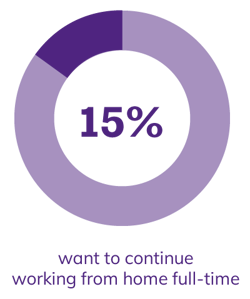


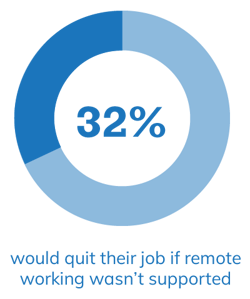
These changing employee attitudes to working locations appears to be directly connected to seeking improvements in lifestyle.
For employers to continue to attract the best talent and retain employees, they need to be flexible in their approach. So what options are available to businesses?
Want to read this offline or share with a colleague? Simply fill in some details to download a copy.
Office space is a significant overhead and changing attitudes to the workplace means that now is a good time to consider that investment. There are a number of different options available, many of which can be combined to offer flexibility for the future.
As remote and flexible working rises, businesses now have the infrastructures to allow employees to work from outside the office. This has led to companies reconsidering their office space.
Does it need to be in an expensive city? Are local offices needed or, with some employees working remotely, can the business operate from a central location?
There have certainly been businesses who have embraced these changes.

Deloitte has announced that it is closing four of its 50 UK offices, moving employees who were based in these locations onto permanent work-from-home contracts.

Barclays have said that they are reviewing their office portfolio, with CEO Jes Slaley saying, “The notion of putting 7,000 people in the building may be a thing of the past."
In fact, 74% of firms say they are reviewing their current office space requirements, particularly those in insurance, finance and banking sectors. And other research shows that of those European companies considering switching to remote working, 25% are doing so to allow them to close offices.
Consolidation of office space also opens up options to move the head office away from the capital, bringing benefits such as lower costs and the opportunity to compete in a less saturated market for talent by moving away from competitors.
Even before the pandemic, businesses were beginning to take advantage of these relocation opportunities. In 2018, Channel 4 moved to Leeds. HSBC’s UK headquarters are in Birmingham. Other businesses are following suit. As the number of people leaving London reached a record high in 2019, companies relocating outside the capital will have an even bigger talent pool than before. Add to that the options of remote working, and location could become increasingly less important.
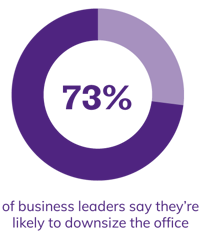
While bigger businesses with multiple offices may look at consolidation, smaller businesses who plan to embrace a hybrid model may find that they can downsize the office.
The key to managing this successfully is to understand how many employees are likely to be based in the workplace at one time and ensure that you understand how much workspace they require to perform their role (while meeting government COVID requirements).
Depending on the type of business, you may find that not all employees want to work remotely or can do so. It’s therefore important to identify which roles will be office-based, hybrid or remote. That data will allow you to optimise the workspace and take advantage of the cost savings a smaller office could bring.
With all the data about relocation, office closures and remote working, it may seem that the traditional office is a thing of the past and future-thinking businesses will no longer require one. But with employees saying they are keen to get back to the office on at least a part-time basis, keeping your existing office may make sense.
Some large corporates are certainly betting on this. In October 2020, PwC said they had no intention of downsizing their office portfolio which is spread across 15 UK cities. Their chairman, Kevin Ellis, said, “Hybrid working is here to stay, and therefore the office will remain a key part of working life.”
PwC are not alone in seeing the importance of office space. Real estate company LandSec are continuing with the construction of three office schemes in London which are worth £967 million.
Of course, keeping the office does not mean that you need to use the spaces in the same way. Research carried out in January 2020, before the impact of the pandemic, found that 85% of employees say a flexible design is important to them, and 77% of respondents said they perform better at work when they have flexible spaces available. Indeed, in May 2020, Nielsen announced that it would be converting its New York office into a team working space for use one or two days a week, while allowing its employees to work from home the rest of the time.
A flexible workspace may allow businesses to adapt to hybrid working and give freedom to change working practices as required in the future.
While these flexible workspaces are often associated with small firms, large corporations such as Apple, Samsung, IBM and Microsoft have all made use of them.
However, the arrival of the pandemic and subsequent lockdowns have had a massive impact on the industry, one which was arguably struggling even before 2020. The thought of sharing office space at a time of social distancing has had a big impact, with data from Coworker showing a huge drop in employees using these spaces.
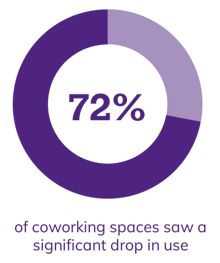
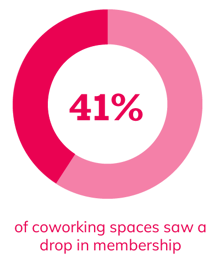

Possibly reflecting a drop in demand for these types of spaces, in May 2020 WeWork made 50% of their community managers and community leads redundant as part of a significant restructure.
The impact of the pandemic is likely to change coworking spaces. But while communal breakfasts and informal networking between businesses may be on hold, these types of workplaces may offer opportunities for businesses looking for non-traditional office space, either as a short-term measure while waiting for some clarity and stability, or on a longer-term basis in as a flexible workspace for staff who are working on hybrid model of remote and office work.
However, there is one final word of caution around these types of spaces. News from the US and Canada shows that some businesses are facing issues with overdue rent and are not protected by eviction moratoriums as the spaces are provided via a membership fee, rather than traditional lease. Until legislation catches up with these new forms of agreement, it’s important businesses carefully consider the implications and flexibility of these types of contract.
There’s no question that remote working increased significantly as a result of the pandemic. Data from the ONS shows that, at the peak of the first UK lockdown between 23rd March and 5th April, almost half of all UK employees were working from home.
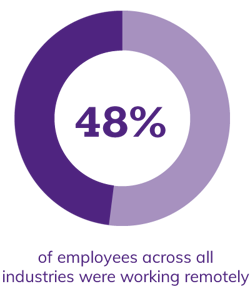
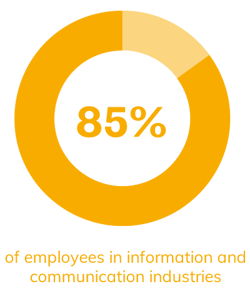

This is expected to continue. Data from IOD showed that 74% of businesses plan to maintain the increase in home working necessitated by the pandemic.
And data from the CIPD shows that employers expect that 37% of employees will continue to work from home at least some of the time, more than double the 18% who did so before the pandemic. And the same data shows that employers expect 22% of staff to work remotely on a full-time basis.
And while many businesses continue to work remotely, either due to government guidance or in the uncertainty about future lockdowns, some businesses have already committed to continued focusing on remote working on a permanent basis.
Crypto-currency company Coinbase has said it is becoming “remote-first” business.
Global asset management firm Schroders has announced that it will be moving to a permanent work-from-home scheme, to increase productivity and talent attraction and retention. Global Head of Human Resources, Emma Holden, said, “Schroders embraced flexible working long before lockdown… But in the space of a few months, we have made 20 years’ progress in attitudes towards flexible working, and we are going to continue with this momentum.”
Given employee expectations, and the advantages of remote working, it seems that remote working is likely to be here to stay.
Whichever option you choose, it’s likely that your workplace will change. If you are offering remote working in the short- or long-term it’s important that you are able to ensure that your business is reaping the benefits and avoiding some of the pitfalls.
In March 2020, when companies had to adapt quickly to the pandemic and the government’s recommendations to work from home, new systems needed to be implemented quickly. Now, many months on, we have a better understanding of the impact and the approaches needed to ensure the office of the future is a healthy and productive workplace, however it may be established.
Businesses worked fast to get the basics in place: file sharing, equipment and internet access are all sorted. But as staff remain working from home, there are key elements that may not have been addressed.
With many people working from a kitchen or dining room table, or even a sofa, ergonomics and safe working practices may not have been considered. In offices, companies often ensure staff have separate screens, keyboards and an office chair but at home people may be working from laptops from a rigid chair. The same health and safety requirements apply whether the worker is at home or office-based, so companies need to ensure they are meeting their obligations. HSE has more information and advice.
Workforce demographics play a huge role in this area. If you have staff from lower socio-economic groups working from home, they are less likely to have a dedicated office space. They may also have slower internet connections and less generous phone contracts. In fact, analysis from the ONS found that higher paid employees were those more likely to be able to work from home – one factor in this may be greater access to technology.
Other research showed that 29% of employees struggle with issues with technology. Research from Cisco found that, alongside ensuring effective communication, 79% of employees think every member of staff should have access to similar technology to their office set-up. It’s important that businesses ensure all employees have this and that lower-paid employees are not disadvantaged.
The final area to consider is data security. There has been a significant increase in cyber attacks since the start of the pandemic and employees may also be putting data at risk: recent data found that 7% of people had uploaded sensitive corporate data to personal cloud accounts. Companies therefore need to that their policies are up to date for a new era of remote working and that employees have the training and tools to keep corporate data safe.
These issues around security become even more pressing for certain industries. For many companies in industries with high levels of data protection and legislation, this may be the first time employees have been offered remote working. There is a risk that industry standards may be harder to meet.
In October 2020, the FCA confirmed that banks need to apply the same levels of conduct and surveillance whether workers are remote or in the office. At the same time, data rules around areas like inside information may change. Companies need to be alert to industry standards when planning remote, flexible or hybrid working and ensure that these rules are applied consistently, regardless of how or where employees work.
Of course, it’s not only industry standards but also government ones that need to be met. Since the arrival of coronavirus, the UK government has issued 14 new guides for different types of businesses to ensure they can operate safely.
Research found that these new standards may actually be driving remote working. 38% of European businesses said they were considering remote working in order to address the difficulty and cost of implementing new safety measures in the office.
A change in working location undoubtedly brings about a change in culture. As we adjust to the reality of working from home, there has been some startling differences between our expectations and the reality.
If we envisaged more free time and commuting time spent relaxing, the reality may be somewhat different. While 23% say they are working fewer hours, other reports suggested we are working longer hours instead, switching the commute for the desk: depending on which research you read, spending 2 hours, 3 hours or even 4 hours longer at work each week.
These longer hours have been cited as a factor in mental health issues, with 49% more staff reporting mental distress than in 2017-2019.
In particular, staying connected can be a challenge. Research found that:
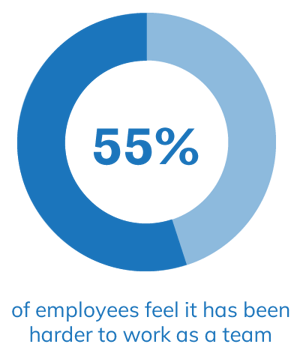
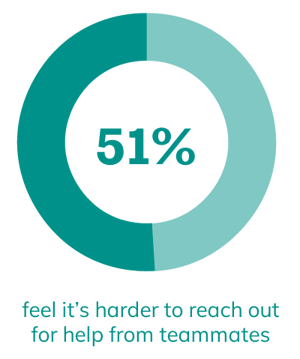
Perhaps that accounts for the increase in the number of meetings, which have risen from 5.9 per day to 6.9, although the average length of meetings have fallen. Looking for new ways to maintain connections is important while employees adjust to a new way of working.
It’s also important that staff feel supported throughout this time.
New research found:
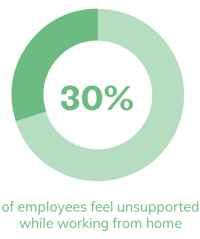
It’s therefore essential that companies are able to adapt their processes to enable everyone to benefit from the opportunities that are opened up by working remotely.
While all this data may seem negative, it highlights the challenges that businesses face in changing to a new working model. One key figure to take away: despite all of the challenges outlined above, 64% of people said they felt that remote working had a positive impact on workplace culture.
At a time when people are focusing on diversity and inclusion, it’s essential that businesses can ensure that this is not negatively affected by changes in the workplace. At the start of the pandemic there was much talk about how different employees may be affected but we now have more data to take a more informed view.
The first conversations were often around how extroverts and introverts may find the “new normal”. Initial comments suggested that extroverts may find the change more difficult and feel isolated from colleagues. This can be true and it’s important that managers ensure the culture supports all individuals and build connections to keep people involved.
However, one area that is less frequently discussed is the impact on introverts, especially as we move to more online communications. In the fast-moving world of Zoom meetings and online chat, extroverts can unknowingly dominate conversations and introverts can find it difficult to make their voice heard.
One company doing excellent work in this area is Ultranauts, who have changed their approach to internal communications, by:
While this approach may need to be adapted to each business, it’s a fantastic model for looking at internal communications differently.
When we talk about inclusion, it’s also essential to look at the impact of remote working on diversity. Changes brought about by COVID have had a bigger impact on some groups, with people from ethnic minority groups being twice as likely to lose their jobs during furlough, which may indicate a worrying bias amongst employers.
For those who remain in work, research found that:
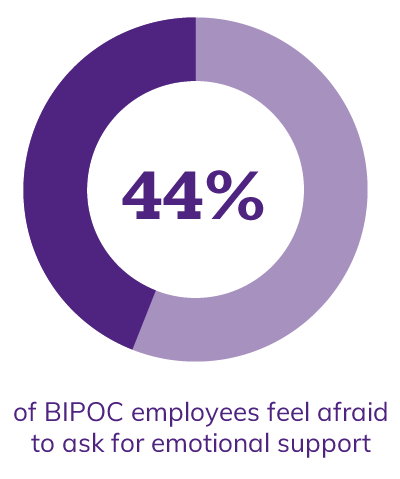
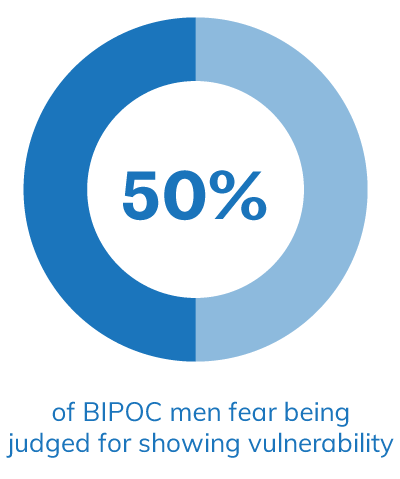
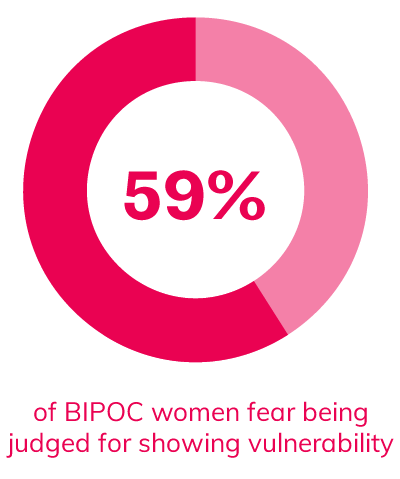
Businesses need to ensure that they create an inclusive culture where employees feel safe to raise issues and ask for the support they need.
When considering if remote working has had a positive or negative effect on gender equality, the picture is complicated. Women in general report feeling less happy and motivated at home than men. Only a third want to stay working from home after the end of the pandemic.
There are many factors that may influence this. One of the key differences at the beginning of lockdown was for parents, where data showed that women were more likely to be impacted by the need to take on additional childcare.
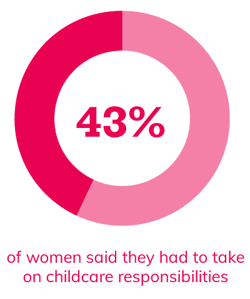



This shows that women continue to take on more of the childcare, which fits with previous research. Data from 2019 which shows that 28.5% of women with children aged 14 and under had cut their working hours due to childcare. The figure is just 4.8% for men.
In addition, women are less likely to have a dedicated, separate workspace in the home: research found that almost 50% of men do vs a third of women. This lack of privacy and separation of work and home could have an impact on the long-term viability of working from home.
However, there have been positive outcomes of changing working spaces and attitudes. What is deemed “professional” may be re-evaluated, as the barriers between home and work blur and as we see more and more TV interviews and Zoom meetings being gate-crashed by children and pets. This may allow all workers to blend work and home life more successfully.
Some women say that working from home gives them more flexibility. And research by Zurich UK found that companies offering flexible working options could see a 20% increase in female applicants for management roles and an overall 16% increase in applications from women, which is good news for businesses looking to address their diversity and inclusion.
These are just some of the inclusion issues affecting businesses as a result of the pandemic. For more information, download a copy of our diversity and inclusion guide.
Want to read this offline or share with a colleague? Simply fill in some details to download a copy.
There are a number of benefits for organisations who can move away from a more traditional office set up for some or all of their employees. These benefits include:
From smaller offices or fewer offices to regional offices, businesses changing their portfolio can see significant cost savings. While relocating an office can have short-term costs (including moving fees and redundancy payouts for those who do not wish to relocate or work remotely), business can make savings in terms of salaries and rent or real estate costs in the longer term.
Recent research found that 70% of SMEs were saving up to £840 a month while their employees were remote working. Perhaps that’s why 25% of European businesses say they are looking at remote working options to allow them to benefit from closing offices.

With companies increasingly looking to minimise their environmental impact, remote and hybrid working minimises travel, which reduces the office carbon footprint. In 2014, the Carbon Trust estimated that a switch to homeworking could save over 3 million tonnes of carbon each year. However, other reports point out that the environmental impact can vary at particular times of the year (better in UK summers, possibly worse in winter as multiple homes are heated). It’s therefore worth investigating the impact for your business before making any claims.
Despite these questions, there may be other benefits to workplace changes. Businesses can see a positive impact by switching to online meetings instead of travelling or switching to a smaller office which is easier to heat and clean.
Lower commuting time can also benefit employees – or can lead to more output if that time is allocated to working instead, as many employees have done.
Data shows that many businesses have seen greater productivity while staff have been working from home. A small survey found 25 of the 26 said that productivity was the same or better during lockdown – and employees agree: 73% said they were more or equally as productive working from home.
As a result of these benefits, 41% of companies looking at remote working options were doing so to make the change to achieve greater productivity.
At a time when 86% of businesses fear losing their top talent as a result of COVID-19, opening up opportunities to a wider talent pool has a significant positive impact.
Over the past 6 months, we have seen a change in attitude and circumstance for our clients and candidates, with businesses more willing to look at candidates from outside their location and candidates less willing to relocate.
While this may settle down in the future, data from LinkedIn shows that remote jobs result in over 20% more geographical diversity in candidates. And this offers opportunities to reach a diverse talent pool who may offer skills not available in your location.
A flexible approach to the workplace not only improves your talent pool, it can also have a positive impact on Employee Value Proposition. As research shows, employees are increasingly looking for flexibility in their workplace, with many citing a hybrid model as their preferred option. Employers who can meet this need enhance their brand and improve their prospects to attract and retain their preferred employees.
Work life balance is seen as an essential part of EVP and new ways of working (with the right systems and culture in place) can deliver this. In a survey in June 2020, 62% of employees said that their work life balance was better than before the lockdown. Employees also report feeling happier overall: research found the “happiness score” for those working from home to be 73% vs the average of 65%.
Finally, data shows that it’s not only businesses who save money with remote working. Employees working from home are estimated to save between £35 and £57 per week depending on where they live, by saving on commuting costs and eating out.
There’s no doubt that 2020 has seen significant changes – many implemented much more quickly than in the past. Businesses who are able to adapt quickly are more likely to survive the changes that a pandemic has brought.
It’s difficult to plan ahead when there is so much uncertainty but having the right insights can help. Businesses who are able to make informed decisions now can set themselves up for the future and attract and retain talent.
While we hope that all of the insights we shared here are useful, it is by necessity general. Our services are designed to give our clients access to robust specific data for their business. Here are some of the ways we can help:
We can provide access to data about different options, including data for different locations (including skills availability, salary and pay scales and competitor data), alongside insights into candidate attitudes to office locations and remote working, and more.
Our global reach allows us to find the right people wherever they may be based, while unlocking key insights to drive your future strategy.
For more details, please contact us.
© Talent Insight Group 2025